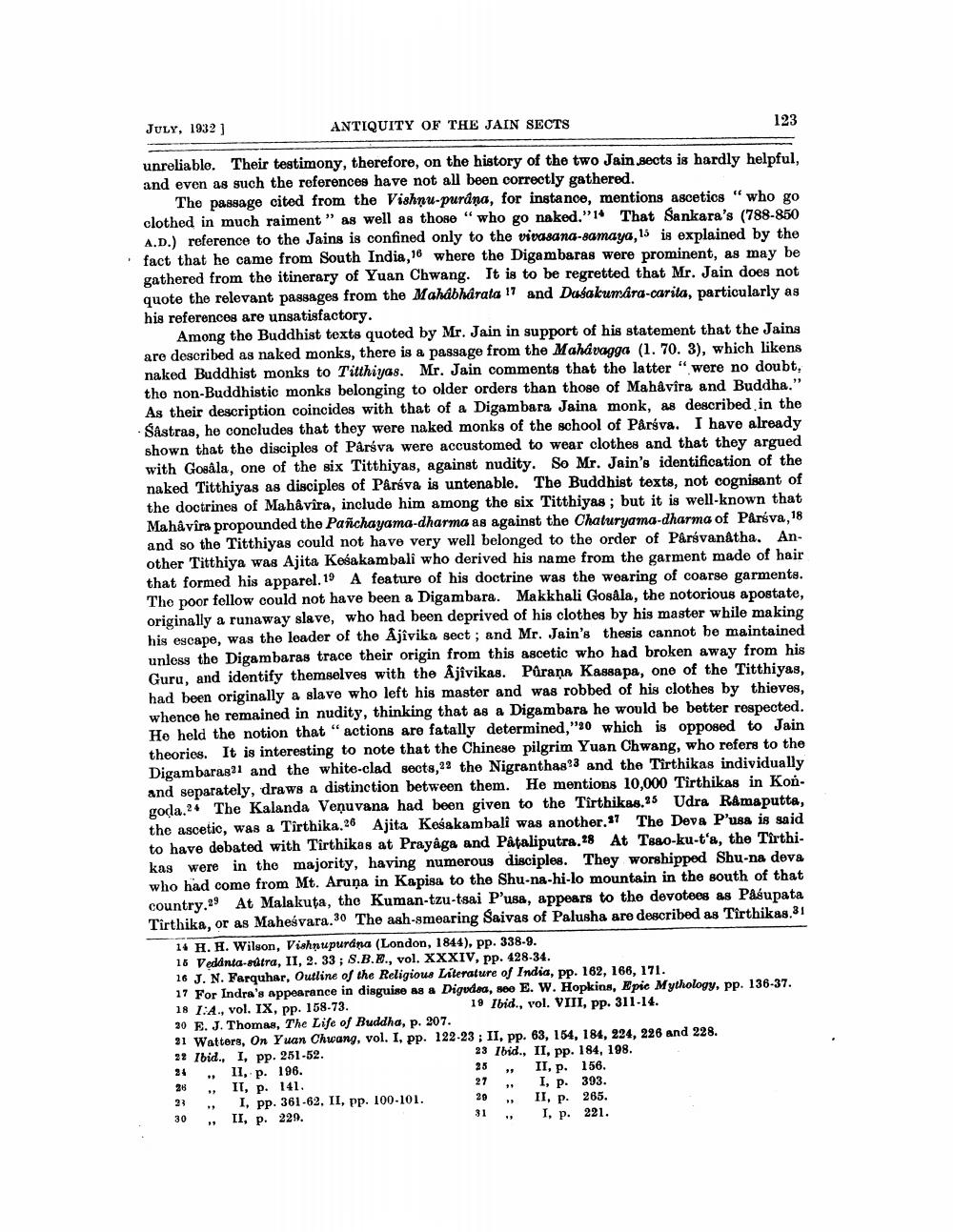________________
JULY, 1932)
ANTIQUITY OF THE JAIN SECTS
123
unreliable. Their testimony, therefore, on the history of the two Jain sects is hardly helpful, and even as such the references have not all been correctly gathered.
The passage cited from the Vishnu-purana, for instance, mentions ascetics " who go clothed in much raiment” as well as those "who go naked."14 That Sankara's (788-850 A.D.) reference to the Jains is confined only to the vivasana-samaya, 15 is explained by the fact that he came from South India, 16 where the Digambaras were prominent, as may be gathered from the itinerary of Yuan Chwang. It is to be regretted that Mr. Jain does not quote the relevant passages from the Mahabharata 17 and Dajakumara-carita, particularly as his references are unsatisfactory.
Among the Buddhist texts quoted by Mr. Jain in support of his statement that the Jains are described as naked monks, there is a passage from the Mahavagga (1. 70. 3), which likens naked Buddhist monks to Titthiyas. Mr. Jain comments that the latter" were no doubt, the non-Buddhistic monks belonging to older orders than those of Mahavira and Buddha." As their description coincides with that of a Digambara Jaina monk, as described in the Sastras, he concludes that they were naked monks of the school of Parýva. I have already shown that the disciples of Parýva were accustomed to wear clothes and that they argued with Gosala, one of the six Titthiyas, against nudity. So Mr. Jain's identification of the naked Titthiyas as disciples of Parsva is untenable. The Buddhist texts, not cognisant of the doctrines of Mahâvîra, include him among the six Titthiyas ; but it is well-known that Mahâvîra propounded the Panchayama-dharma as against the Chaturyama-dharma of Parsva, 18 and so the Titthiyas could not have very well belonged to the order of Parávanátha. Another Titthiya was Ajita Kesakambali who derived his name from the garment made of hair that formed his apparel. 19 A feature of his doctrine was the wearing of coarse garments. The poor fellow could not have been a Digambara. Makkhali Gosála, the notorious apostate, originally a runaway slave, who had been deprived of his clothes by his master while making his escape, was the leader of the Ajivika sect; and Mr. Jain's thesis cannot be maintained unless the Digambaras trace their origin from this ascetic who had broken away from his Guru, and identify themselves with the Ajivikas. Parana Kassapa, one of the Titthiyas, had been originally a slave who left his master and was robbed of his clothes by thieves, whence he remained in nudity, thinking that as a Digambara he would be better respected. Ho held the notion that "actions are fatally determined,"30 which is opposed to Jain theories. It is interesting to note that the Chinese pilgrim Yuan Chwang, who refers to the Digambarag?1 and the white-clad sects, 22 the Nigranthas?3 and the Tirthikas individually and separately, draws a distinction between them. He mentions 10,000 Tirthikas in Kon. goda.24 The Kalanda Venuvana had been given to the Tirthikas.25 Udra Ramaputta, the ascetic, was a Tirthika.26 Ajita Kesakambali was another.37 The Deva P'usa is said to have debated with Tirthikas at Prayaga and Pâtaliputra.18 At Tsao-ku-t'a, the Tirthikas were in the majority, having numerous disciples. They worshipped Shu-na deva who had come from Mt. Aruņa in Kapisa to the Shu-na-hi-lo mountain in the south of that country.29 At Malakuta, the Kuman-tzu-tsai P'usa, appears to the devotees as Pasupata Tirthika, or as Mahesvara.30 The ash-smearing Saivas of Palusha are described as Tirthikas.31
14 H. H. Wilson, Vishnupurana (London, 1844), pp. 338-9. 16 Vedanta-sutra, II, 2.33; S.B.E., vol. XXXIV, pp. 428-34. 16 J. N. Farquhar, Outline of the Religious Literature of India, pp. 162, 166, 171. 17 For Indra's appearance in disguise as a Digudad, 300 E. W. Hopkins, Epic Mythology, pp. 136-37. 18 1:A., vol. IX, pp. 158-73.
19 Ibid., vol. VIII, pp. 311-14. 30 E. J. Thomas, The Life of Buddha, p. 207. 31 Watters, On Yuan Chwang, vol. I, pp. 122-23; II, pp. 63, 164, 184, 224, 226 and 228. 22 Ibid., I, pp. 251-52.
23 Ibid., II, pp. 184, 198. 34 . II, p. 196.
25 . II, p. 156. 36 . II, p. 141.
I, p. 393. 23 . I, pp. 361-62, II, pp. 100-101.
II, p. 265. 30 . II, p. 229.
I, p. 221.
27




